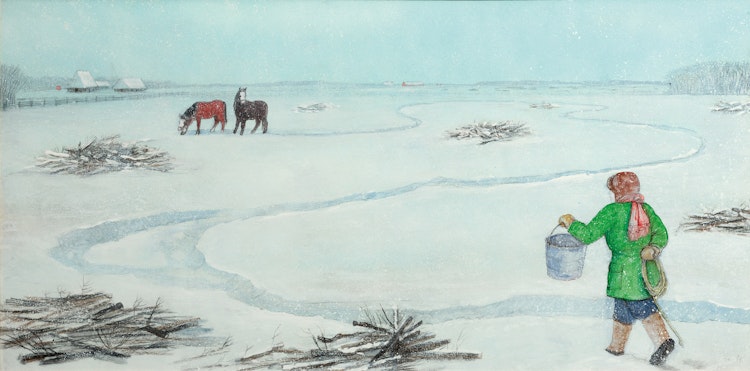Farm Scene with Two Horses (Going to Feed and Rope), 1974 by William Kurelek




Preview this item at:
Cowley Abbott
326 Dundas St West
Toronto ON M5T 1G5
Ph. 1(416)479-9703
William Kurelek
Farm Scene with Two Horses (Going to Feed and Rope), 1974
mixed media on board
signed with monogram and dated 1974 lower right; inscribed with the artist's name and "Bau-Xi Gallery, Vancouver" (struck) on the reverse; housed in the artist's handmade frame
17 x 34 in ( 43.2 x 86.4 cm )
Auction Estimate: $100,000.00 - $120,000.00
Acquired directly from the Artist
Private Collection, Ontario
Avrom Isaacs, preface to "William Kurelek: An Exhibition of Paintings and Drawings, 1972-1974", Brantford, 1974, unpaginated
Patricia Morley, "Kurelek: A Biography", Toronto, 1986, page 224
This panoramic scene depicts a farmer trudging over a snow-covered field, following a packed, meandering path that leads to a pair of horses. He holds aloft a bucket of feed, while concealing a coil of rope behind his back, enticing the animals with food so that he can accomplish an ulterior goal. The painting—its landscape and the activity taking place—reimagines the world of Kurelek’s youth. He was born east of Edmonton in 1927 and raised on a farm north of Winnipeg. His parents, relatives, and many of their friends had either arrived on the Prairies from rural Ukraine over the previous three decades or were the second-generation offspring of immigrants. The two thatched-roofed structures on the painting’s horizon replicate the village houses common in the communities of Kurelek’s ancestors, the first permanent lodgings many Ukrainian newcomers built in Western Canada before constructing a modern North American farmhouse.
"Farm Scene" encompasses two subjects that are central to most of the artist’s mature oeuvre: the virtuous grit of farm life and pride in Ukrainian cultural identity. While Kurelek sometimes treated these subjects separately—he completed series documenting the agrarian experiences of other cultures in Canada and depicted Ukrainian Canadians in contexts beyond farm and field—his tendency to draw inspiration from personal memory ensured they often appeared entwined. Kurelek’s interest in his Ukrainian heritage was rekindled in the mid-1960s by the Ukrainian Women’s Association of Canada, whose members encouraged him to paint what became "The Ukrainian Pioneer Women in Canada" series for display at Expo 67 in Montreal. His interest in documenting farm life intensified after settling in Toronto in 1959, during a series of road trips the artist made through Western Canada beginning in 1963. These two interests became increasingly interwoven in work created after 1970, when Kurelek travelled to what was then Soviet Ukraine for the first time. He described the “steep thatched roofs” of the old country as a “delightful, paintable [subject].” Their combined realization in "Farm Scene" came at a time when Kurelek was experiencing his greatest renown, in Canada as well as the United States.
And yet, as with so many of the artist’s popular genre paintings, what at first seems pleasantly mundane and nostalgic about "Farm Scene" hints at deeper meanings that ultimately reflect the Roman Catholic faith that had been Kurelek’s guiding light since the late 1950s. Indeed, as his longtime dealer Avrom Isaacs perceptively put it in 1974, the same year this work was painted: “You think you have acquired a nice [P]rairie landscape, but after a while you realize that there is a great deal more there than meets the eye.” For Isaacs, Kurelek was a religious artist at root, “regardless of his subject matter.” The farmer’s homely and humorous attempt to trick his horses also carries the dimension of a painted parable, Kurelek encoding a subtle reminder of humanity’s capacity for deceit on a minor stage of everyday life.
We extend our thanks to Andrew Kear, Canadian art historian and Head of Collections, Exhibitions and Programs at Museum London for contributing the preceding essay. Andrew is the past Chief Curator and Curator of Canadian Art at the Winnipeg Art Gallery, a curator of the 2011-2012 national travelling exhibition "William Kurelek: The Messenger" and author of the "Art Canada’s Institute’s William Kurelek: Life & Work" (2017).
Register to Bid
To participate in our auction by telephone or absentee bid, please register below. You may also download a bid form and email a completed copy to [email protected] Bidding registration must be submitted by 12:00 Noon ET on Wednesday, May 28th.
Bid in Person Telephone Bid Absentee Bid Download Bid Form
Already have an account? Sign-In
Register to Bid Online
To register to bid online during our live auctions you will be taken to a different website hosted by Auction Mobility. A new account, separate from your regular Cowley Abbott Client Profile, will need to be created prior to online bidding registration.
Bidding registration must be submitted by 12:00 Noon ET on Wednesday, May 28th.
Please Note: All bidding through the Auction Mobility site and apps is subject to a 21% Buyer's Premium
Get updates or additional information on this item
Watch This Item Ask a Question Request Condition ReportShare this item with your friends
William Kurelek
(1927 - 1977) RCA
Born on a farm near Willingdon, Alberta in 1927, William Kurelek created paintings that explored the reality of farm life during the Depression, with a focus on Ukrainian experiences in Canada. Kurelek’s mother’s family settled in Canada during one of the first waves of Ukrainian immigration in 1899 before the painter’s father arrived in Alberta from Western Ukraine during the second major wave to the province in 1923. In 1934, Kurelek’s family moved to Manitoba, near Winnipeg, due to falling grain prices and a fire that destroyed their home. Upon moving to Manitoba, Kurelek began attending school at the Victoria Public School.
Influenced by the apprehension surrounding the Depression, World War I, and the instability of farming, Kurelek focused on his studies. However, his father did not approve. While Kurelek’s father valued physical labor on the farm, Kurelek concentrated on school and drawing, which caused tension in his household. As a child, Kurelek covered his room in drawings from literature, dreams, and hallucinations. At school, Kurelek’s classmates were enthralled by his stories and drawings.
In 1943, Kurelek and his brother attended Isaac Newton High School in Winnipeg. While in Winnipeg, he frequented Ukrainian cultural classes offered by St. Mary the Protectress. In 1946, Kurelek enrolled in the University of Manitoba studying Latin, English, and history. While in university, Kurelek’s mental health spiraled, which he later self-identified as depersonalization.
After university, in 1948, Kurelek’s family relocated to a farm near Hamilton, Ontario. The next fall, in 1949, Kurelek began studying at the Ontario College of Art working towards a career in commercial advertising. While in school he was uninterested in the competitiveness and emphasis on earning high grades. So, he decided to study with David Alfaro Siqueiros in San Miguel de Allende, Mexico. During his hitchhike to Mexico, Kurelek experienced his first mystical experience while sleeping in the Arizona desert. In this vision, a robed figure asked him to look after his sheep. Upon his arrival to Mexico, Kurelek learned that Siqueiros had departed, and the program was under new direction by Sterling Dickinson. Dickinson’s program was more informal and allowed Kurelek to become aware of social issues and develop his belief system.
Kurelek returned to Canada in 1951 and traveled to England in 1952 where he was admitted into a psychiatric treatment center at London’s Maudsley Hospital. The doctors noted the severity of his illness as well as his artistic talent. After his discharge, Kurelek traveled throughout Europe to view works by Northern Renaissance painters, such as Jan van Eyck and Hieronymus Bosh. In 1953, Kurelek was readmitted into Maudsley, then transferred to Netherne Hospital in Surrey, which had a cutting-edge therapy program. He continued to paint during this time. In early 1955, Kurelek was discharged and returned to London where he worked at an art framing studio, apprenticing with Frederick Pollock.
“Stephen Franklin in ’Weekend Magazine’ described his years in England as follows, ‘In seven years Kurelek found both happiness and sadness in London. His painstaking fool-the-eye paintings of pound notes and other objects found their way into three Royal Academy summer shows, but he was increasingly bothered by eye trouble for which there was no physical cause. He plumbed the depth of emotional despair, contemplated suicide, and wound up in hospital for more than a year. It was here that he began his conversion – from boyhood membership in the Orthodox Church and subsequent atheism – to Catholicism which has deeply affected his life since.’
It was there that he drew many self-portraits and scenes of farm life from his youth. He also developed his unique style of outlining the drawing with a ballpoint pen, using coloured pencils for texture and adding details in pen. Careful examination of his drawings reveals images full of realism with minute details of things like cots, clothes and even insects. Under the pen of William Kurelek, prairie farm scenes and landscapes came to life.”
Kurelek permanently returned to Canada in 1959. Later that year he met Avrom Isaacs, of Isaacs Gallery, who invited him to work in his gallery’s frame shop and hosted his first solo exhibition in 1960. In 1962, Kurelek married Jean Andrews and they relocated to the Beaches area in Toronto. Following the Cuban Missile Crisis, he began painting in a “fire and brimstone” style and constructed a fallout shelter in his basement, which eventually became his studio. He visited Ukraine in 1970 and 1977 and during this period he took a multicultural approach to his art. After his second trip to Ukraine he was admitted to St. Michael’s Hospital in Toronto and soon passed away from cancer.
Literature Sources:
Andrew Kear, “William Kurelek: Life and Work”, Art Canada Institute, Toronto, 2017 (https://aci-iac.ca/art-books/william-kurelek)




